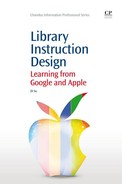Conclusion
Two forces in the universe, yin and yang, affect people’s lives in different ways, according to Chinese philosophy. Both are powerful and they complement each other. Wise people will detect these forces and regulate their lives accordingly.
Google and Apple, yin and yang, follow quite different philosophies and principles in their product design. The Google style is data-driven and bottom-up, while the Apple style is vision-driven and top-down. Their approaches are seemingly opposed, but both are extraordinarily successful, as we witnessed in the history of corporate America.
Library instruction design may borrow ideas from these differing but complementary approaches to effectively achieve various teaching goals. To learn from Google and Apple, we may divide instruction programs into two categories: patron-initiated instruction (the Google style) and instructor-initiated instruction (the Apple style), or yin and yang. Based upon the nature of various instructional programs, library instruction in Google style may work well in reference service, research consultation, one-shot workshops, integrated classes, and with an embedded librarian; while library instruction in Apple style may work well in bibliographic instruction, thematic lectures, graduate seminars, and credit-bearing library courses. Library orientation, on the other hand, can use either Google style or Apple style, depending on the audience and purpose of the orientation. The following table suggests suitable teaching styles for the design of library instruction programs. To conclude this book, let me summarize the idea of applying the Google and Apple styles to library instruction design. To put the concept in perspective, a library instruction program in Google style teaches what the learner wants to learn, while a library instruction program in Apple style teaches what the learner needs to learn. ‘Want,’ as defined by the ever-improving Google Dictionary, with etymological information from the Oxford English Dictionary, means ‘have a desire to possess or do (something); wish for.’ It is the learner’s desire and wish that drive the program. ‘Need’ means ‘require (something) because it is essential or very important.’ (Google Dictionary). It is the instructor’s knowledge and vision that decide what the learner should learn. These two design philosophies reveal different learning initiatives reflecting the current status of library instruction in modern society. The following table summarizes the characteristics and features of the two styles.
Table 7.1
Suitable styles for the design of library instruction programs
| Library instruction programs | Google style | Apple style |
| Library orientation and tour | ✓ | ✓ |
| Reference service | ✓ | |
| Research consultation | ✓ | |
| One-shot workshop | ✓ | |
| Integrated class | ✓ | |
| Embedded librarian | ✓ | |
| Bibliographic instruction | ✓ | |
| Thematic lecture | ✓ | |
| Graduate seminar | ✓ | |
| Credit-bearing library course | ✓ |
Table 7.2
Comparison between the two styles applied to library instruction
| Google style | Apple style |
| Service-oriented | Guidance-oriented |
| Patron-initiated | Instructor-initiated |
| Data-driven | Vision-driven |
| Offers what the learner wants to learn | Offers what the learner needs to learn |
| Focuses on current tasks | Emphasizes long-term outcomes |
| Bottom-up design | Top-down design |
| Yin | Yang |
Library instruction uses various teaching forms that serve different purposes and aim at different goals. When we design and prepare a library instruction program, it is wise to first understand the mission of the program, and then apply a suitable style to our design of the program. It is this author’s belief that both styles should be able to coexist in the information age, because they each serve different educational purposes, just like yin and yang.
